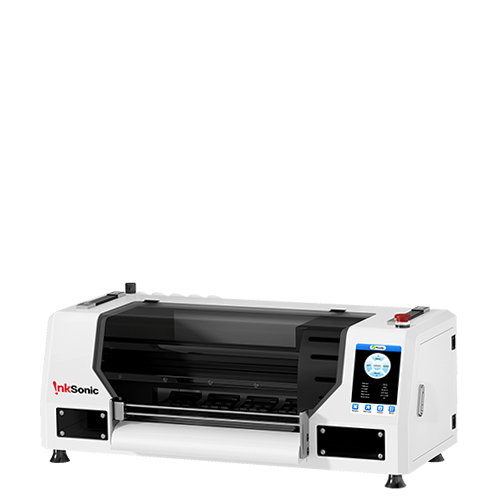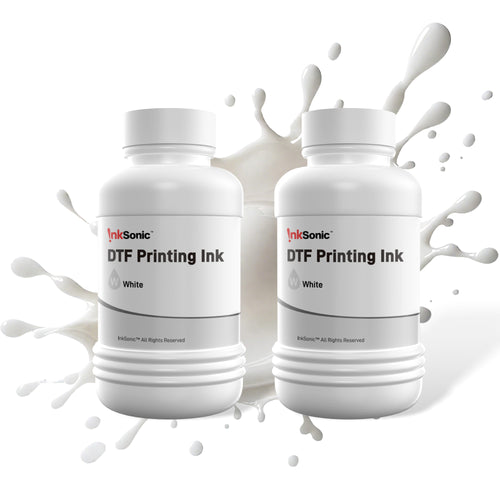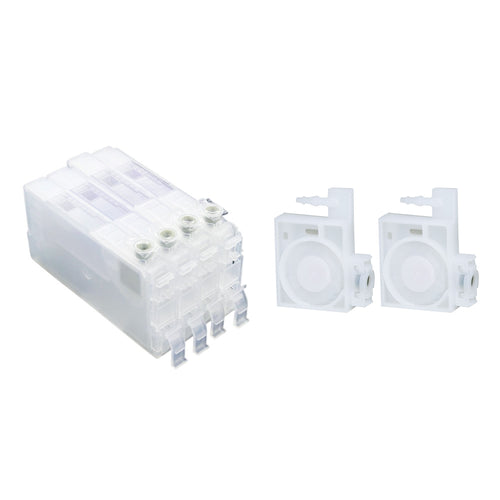1. Introduction
DTF white ink not printing is among the most common problem faced by DTF printing users. If not addressed properly, these problems can delay, increase costs, and potentially damage your printer.
The good news is that most issues in DTF printing are fixable. Many can be resolved through self-troubleshooting with the detailed guide provided below. And for more advanced and complex issues, InkSonic's 24/7 1-on-1 support is available to assist you.

In this blog, we will explore the common causes of white ink problems in DTF printing and provide clear, step-by-step troubleshooting and solutions to help you resolve the issue effectively. Keep reading for practical advice and expert guidance on how to keep your DTF printing process running smoothly!
2. Understanding White Ink and Its Importance
To better understand the causes and solutions of the issue, let's get to know what is DTF white ink and its importance first.
2.1 What is DTF White Ink?
DTF White Ink is composed of a unique mix of pigments and chemicals designed for direct-to-film printing. One of the challenges of using it is that it contains titanium dioxide, a unique pigment that has been used for years to create vibrant colors, but over time, it settles due to gravity.
High-quality ink is crucial for delivering excellent designs and long-lasting prints. 🐼 Inksonic white ink is ideal for DTF printing, offering a more stable and high-quality printing experience

2.2 Function and Importance
- Provide a base layer on colored fabrics, ensuring that the design stands out clearly.
- Reproduce the color white on dark or colored materials, allowing white elements to be included in the design.
- Brighten colors and enhance the contrast in the image and makes the design pop.
2.3 Common Challenges
Sedimentation and clogging.
The ink sac or ink tube interface has poor contact, resulting in bubbles.
Inconsistent density.
There are some particles in the ink, which may cause the nozzle to wear, print blockage, and slanted printing.
3. Not Printing and Its Solutions
If you're facing issues with DTF white ink not printing, the cause can vary. Here’s a breakdown of the common problems and their solutions, helping you troubleshoot step by step:
3.1 Check if Spot Layer is Required
Solutions: Some DTF printers, like the InkSonic XP600 DTF printer , require you to create a spot layer for the white ink before printing. This step is crucial for ensuring that the ink is applied correctly. The process is quick and easy—just follow the tutorial above to make sure the spot layer is properly set up.
3.2 Check If DTF Print Head is Clogged
Cause: A clogged printhead is one of the most common problems with white ink not printing. This can be caused by a buildup of ink accumulation. Or by using the printer's built-in cleaning function. Regular maintenance is key to preventing this problem.
Solutions:
You can clean the print head manually by right-clicking on the printer driver and performing a head cleaning one to two times.

3.3 Check If There's Sediment or Low Levels in the Ink Tank
Cause: Over time, sediment from the white ink can accumulate in the ink tank, or the ink level may be too low. Ensure the ink supply is adequate and check for any sediment buildup.
Solutions:
Shake the DTF ink tank or stir it with a clean stick.
Refill the ink tank with high-quality ink if the levels are low.
If necessary, replace the ink and clean the tank to prevent blockages.
3.4 Check if There's Air in the Ink Cartridge
Cause: Air bubbles or settled particles can prevent proper ink flow, thus causing issues and poor printing results.
Solutions:
Use a syringe to draw out trapped air or sediment from the ink system.
Check all connections to ensure the cartridge is properly sealed to avoid air intake.
3.5 Check If There's Incorrect DTF Settings in Software
Cause: Low DTF white ink density or incorrect printer settings can result in poor or no output.
Solutions:
Adjust the density settings in the printer software to achieve optimal output.

3.6 Check if Ink Pad and Wiper Blade are Overloaded

Cause:
- Ink Pad: The ink pad absorbs waste ink during the printer's head cleaning process. Over time, the spring under the ink pad may become loose due to long-term use. This can cause issues such as ink not printing properly because the pad can no longer effectively manage the waste ink buildup.
- Wiper Blade: The wiper blade, the one near the print head, help clean ink and dust off the DTF print head. If the wiper blade accumulates too much ink, it can contaminate or even scratch the print head, leading to print quality issues.
Solutions:
- Ink Pad Cleaning : Turn off the printer and unplug it. Remove the ink pad and clean it with a cleaning solution or replace it when necessary. After cleaning, allow it to dry completely before reinstalling. We recommend replacing it every 3 months if the printer is used regularly.
- Note: Since the ink pad is a consumable part, it's important to track its usage. If it's been over three months and you're facing issues with not printing, we recommend replacing the ink pad. This is often the most efficient and quickest way to resolve the problem.
- Wiper Blade Cleaning: Open the maintenance cover and wipe the wiper blade to remove any dried ink. After cleaning, reinstall it. If the blade is damaged, replace it with a new one.
3.7 Check if the DTF Printer Cleaning Unit is Clogged.

Cause: If the DTF printer’s cleaning unit is clogged, it can interfere with the printing process.
Solutions:
If black ink cannot be discharged after cleaning, use a syringe to extract the waste ink directly from the waste ink tube.
Repeat the process of extracting the waste ink several times until the waste ink is discharged, and then do it once again nozzle cleaning, finally progressing to a nozzle check.
3.8 Check for Incorrect Film or Powder Usage
Cause: Low-quality or incompatible PET film or powder can affect ink adhesion, leading to missing white ink layers or poor opacity.
Solutions:
Use hot peel or cold peel film recommended by your printer manufacturer.
Use fine, dry DTF powder with good adhesion qualities.
Ensure film is stored properly—no moisture or dust contamination.
4. Advanced Troubleshooting
(Please have InkSonic's tech team get involved)
The solutions above should solve your problem. If not, please contact InkSonic customer service as soon as possible. Our experts will help you diagnose and resolve the problem. Trying to fix it yourself may cause further damage or void your warranty.
4.1 Check Circulation Pump

Cause: If there is air or a blockage in the white ink circulation system, it may cause it not to appear.
Solutions:
Please contact our professional customer service team for help. Avoid attempting to resolve it yourself, as it may lead to severe issues.
4.1.1 Additional Information: The Importance of Circulation System
DTF white ink's unique properties make it prone to sedimentation. This is a leading cause of many issues. To address this, Inksonic has introduced innovative solutions for DTF printers :
3-in-1 Circulation System : Our printers feature a continuous ink supply system (CIS) that integrates white ink circulation, mixing, and filtration, improving ink flow, reducing sedimentation, and extending print head life by 50% compared to traditional printers
Automatic Stirring : Turn on the DTF machine, and the white ink circulation will automatically start. This is to prevent white ink from settling, it is recommended to activate the white ink circulation system on a daily basis.
4.2 Persistent Clogged Print Head
Solutions:
Soaking Method : Soak the print head and ink pad in nozzle cleaning liquid to dissolve any dried ink and debris.
Manual Cleaning : Use a syringe to inject cleaning fluid into the print head. It breaks down clogs. Then, remove the loosened debris. Flush the head with nozzle cleaning liquid to clean it.
4.3 The Channel of Printer Head is Clogged
Cause: DTF White ink tends to clog the print head channels more easily because its pigment particles are larger, whereas color inks have finer particles that are less likely to cause blockages.
As a result, color ink can flow through smaller channels more easily. Even if the white ink print head channel becomes clogged, color ink may still pass through. This means you can swap the white ink and color ink channels to resolve the issue and allow the ink to flow through the color ink print head channel.

Solutions:
Swap the positions of the two cartridges with the yellow and black ink cartridges.
5. Maintenance Tips for DTF Printers
To keep your DTF printer in top shape and avoid white ink issues, follow these maintenance practices.
Routine Cleaning: Each time before starting the machine to print, you need to clean it and print a test strip to check the printing effect.
Waste Ink Management: Regularly empty the waste ink tank and monitor its capacity.
Use quality ink: Buy high-quality ink. It will reduce sediment and improve output.
Shake White Ink Bottles: Shake white ink bottles for at least 30s to 60s or stir them with a clean stick before and after each printing session.
When the printer is not used for a long time, please connect an external moisturizing device to protect the printhead.
For a more complete maintenance guide on each printer, read the maintanance guide of inksonic printer.
Above are the common issues with white ink and their troubleshooting steps. If you're unable to resolve the problem, don’t hesitate to seek professional support. Contact InkSonic’s tech team for 1-on-1 assistance.
FAQ
Q1: Why is only my color ink printing but not the white?
This usually indicates a problem specific to the white ink system. Common causes include:
A clogged ink channel in the print head
White ink sediment buildup in the tank or ink line
Missing spot color/layer settings in the RIP software
Incorrect ink settings in the print profile
Start by running a nozzle check. If the ink is missing, follow the troubleshooting steps in Section 3.
Q2: How often should I clean my print head to prevent clogs?
For optimal performance, especially with white ink, it's recommended to:
Run an automatic head cleaning every 1–2 days if printing daily
Perform a manual cleaning (including the cap top and wiper blade) every 2–3 days
Deep clean or flush the head once a week if usage is high
White ink is more prone to clogging due to titanium dioxide particles, so regular maintenance is key.
Q3: What’s the difference between automatic and manual white ink circulation systems?
Automatic Circulation:
Built-in motorized system that runs at set intervals
Keeps white ink moving through the tank and lines to prevent sedimentation
Usually activates when the printer is powered on
Manual Circulation:
Requires the user to manually stir, shake, or trigger the circulation with a button or syringe
More prone to inconsistent results if not performed regularly
InkSonic printers come with a 3-in-1 automatic white ink circulation system for reliable, low-maintenance operation.


































